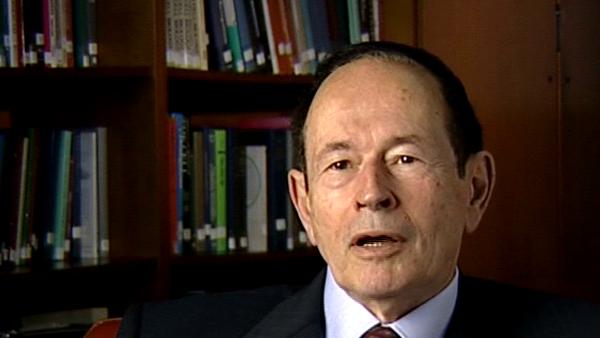This is called re-entry and I suppose I can convey the idea by an analogy and also by setting up some structure. In your brain there are vast parts of, say, the cortex of your brain – that wrinkled structure I mentioned before – which are connected back and forth by parallel fibers, massively parallel fibers. They're also connected side to side. For example, your right cortex is connected to your left and vice versa though something called the corpus colosum. The corpus colosum has about 200 million axons going back and forth in both directions, mapping maps that are similar but not identical on each side of your brain. So when inputs come to those they send inputs back to the other side of your brain.
Well, imagine all these things happening at once and never staying still. Well, this is quite different than what you have, say, in this camera in some of the electronic devices. It's not feedback. Feedback is when you try to put an error signal in, after you've put an input in back to the original case with a correction; say, if you put in a sine wave and you want an amplified sine wave, if it's an error you send back the error and correct it, etc. In this case nothing of the sort is possible because we've assumed it's not a computer, it's not an electronic circuit; it's a selectional system. So when inputs come in to the two sides of your brain and they send inputs to each other over this massively parallel set of fibers, what's happening? Well, it's re-entry.
Re-entry is a recursive process of changing synaptic strengths across massively parallel connections in different parts of the brain. And what it tends to do is synchronize the circuits that connect these things in such a way that, out of the myriad numbers, certain ones are picked over others so they're selected. So here we have a kind of analogy with immunology; but we have to be careful here because the analogy's also with evolution. All of these selectional processes have three steps: the first step is the origin of diversity – you have to have some way of making differences. Second, you have to poll that which is going to be recognised by the recognizer or vice versa. And third, you have to get some form of differential amplification of ones that fit the past. In evolution you get the diversifier by mutation; you get the circling from behavior and competition in the environment, and, finally, in the third case, you get differential reproduction of the progeny of those animals that are more fit.
In immunology you have this process of somatic variation I talked about, where you make a whole bunch of different antibody combining cells, each 10¹¹ of them – 10 followed by 11 zeros – of different cells, each with a different antibody, one each. And then you pick those that bind a particular foreign molecule, even one that never existed before, and you stimulate the production of those cells, so that the next time around you see more antibodies of that kind. Well, in the brain what is it? Well, in the brain it is that a developmental and experiential selection cause an enormous repertoire of variant dynamic circuits. But here it's much harder. You have to think of the whole thing as very dynamic because there are signals flying back and forth all over the place in this closely coupled anatomy. And what seems to hold the whole thing together is this business of re-entry – namely... and we've tested this here in a series of theoretical models, namely the idea that, through re-entry and constant correction you will get synchronous circuits that work to be part of that repertoire and are selected. How are they selected? Because the synaptic strengths are increased mutually.






